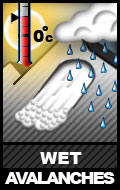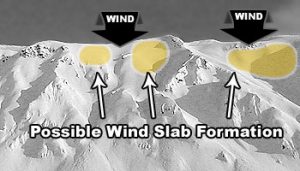Springtime Avalanche Outlook
For the remainder of the forecasting season, we will be providing updates as warranted by conditions rather than each weekend.
This is a regional backcountry avalanche forecast for the Western Chugach Mountains of Chugach State Park. It is provided pro bono by a local avalanche professional, is based on limited field data for a large area, and is meant to be used only as a general baseline for recreationists’ personal and specific assessment in the field. The Anchorage Avalanche Center and associates assume no responsibility or liability for the use of this information. Anyone using this information needs to be formally educated in regard to avalanches and backcountry travel. Please encourage statewide investment in high quality outdoor and environmental education via K-12 public schools, as this is the best way to ensure all Alaskans are “avy savvy.”
Click the hyperlinks and icons for further learning.
This is a springtime avalanche forecast update for April 12-14, 2020.
Avalanche danger has increased to considerable and is expected to remain elevated through the forecast period of Sunday-Tuesday. Dangerous avalanche conditions exist: both natural and human triggered avalanches are likely! If you recreate in the mountains in the coming days make sure you know how to identify and avoid potentially dangerous avalanche terrain. This includes being aware of overhead avalanche danger even if you’re on flat ( and maybe even snow-free) terrain, as many popular trails in Chugach State Park are exposed to avalanche paths (e.g. Penguin Ridge, Indian Creek, Falls Creek, Powerline Trail, Little O’Malley gully, the last ~1.5 mile of South Fork Eagle River before the lakes). Low visibility in the alpine will further complicate backcountry travel and make potentially dangerous avalanche terrain harder to identify.
If you are determined to get out in the mountains during these dangerous conditions, it will be especially important to practice safe travel protocols and effective terrain management to minimize exposure to potentially dangerous avalanche terrain and reduce the consequences if an avalanche is triggered. Be mindful of terrain traps that could cause debris to pile up more deeply, and exposed terrain where a fall or loss of control due to even a small avalanche could lead to significant trauma.
Considering the bad weather, COVID-19 public health crisis, and dangerous avalanche conditions; we do not recommend recreation in avalanche terrain during this forecast period. All these factors will limit and/or complicate search and rescue. There’s still plenty of spring sunshine to come, the snow will be around for several more weeks, and conditions will eventually improve. We recommend being patient and waiting for better weather and safer conditions for mountain recreation.
Winter is finally loosening its grip on Southcentral Alaska and with the arrival of relatively warm and stormy weather the next few days, springtime is pushing winter away.
A few to several inches of upper elevation snow, lower to mid-elevation rain, and moderate to strong winds are all factors that will increase avalanche danger and keep it elevated through this forecast period. Both human and naturally triggered avalanches are likely with widespread small avalanches (D1), localized large avalanches (D2), and isolated very large avalanches (D3).
It’s also the time of year when rockfall is a serious mountain hazard. Warm temperatures, rain, and wet snow will de-stabilize and lubricate loose rock that had been glued into place during winter. Where a helmet around steep, rocky terrain and be mindful of rockfall danger!
Problem 1 – Wet Avalanches
Both natural and human triggered wet avalanches are likely.
Expect localized wet slab avalanches to release from terrain steeper than 35º across all aspects in the lower to mid-elevations. These wet slabs could be up to D3 in size (powerful enough to destroy a vehicle or wood-frame house) and run from steep upper elevation terrain all the way down to flat (and possibly even snow-free) lower elevation terrain.
Widespread persistent weak layers exist in the Western Chugach snowpack in the form of the very significant January facet layer, as well as basal facets and depth hoar near the ground. While these layers have been relatively dormant the past couple weeks due to melt-feeze cycles and generally cold temperatures, they are expected to reawaken (and potentially fail catastrophically) due to lubrication and a loss in strength from warm temperatures and rain.
Expect widespread loose wet avalanches up to D2 in size (large enough to bury, injure, or kill a person) to release from terrain steeper than 40º across all aspects in the lower to mid-elevations. These will be most dangerous where terrains traps and/or exposure increase the consequences. They may also trigger larger and more dangerous wet slabs as they descend.
Rather than digging snowpits and conducting stability tests, wet avalanches are better assessed by being mindful of the snowpack’s level of saturation. Considering the widespread persistent weak layers mentioned above, wet avalanches will become likely anywhere rain and warm temperatures have broken down a previously supportable crust.
Problem 2 – Wind Slab
Both natural and human triggered wind slab avalanches are likely.
Expect wind slabs up to D2 in size to release from leeward terrain (primarily west clockwise to north aspects) steeper than 35º above 3000′.
Moderate to strong (primarily E to SE) winds with a few to several inches of alpine snow will build fresh wind slabs. The most suspect areas are wind-loaded upper elevation terrain near peaks and ridges, and cross-loaded features.
Dangerously wind-loaded snow may feel hollow and punchy, indicating a denser slab overlying looser and weaker snow. It may look pillowy, bulbous, and/or have a smooth, lens-like appearance.
Quick hand pits are an effective means of assessing how recent snow has bonded to old snow surfaces, which generally consisted of firm to very firm faceted wind-packed snow and crusts. These old snow surfaces are not expected to provide a very cohesive and stable interface with new snow, given the low friction. However, considering relatively warm temperatures and the resulting moist and sticky snow, newly developed slabs may bond quickly. Convex, and/or unsupported terrain features, are the most likely place for human triggered wind slabs.
As always, do your own assessment of stability in the area in which you’re traveling. If you are determined to expose yourself to terrain steep enough to slide, don’t just dive in. Think about consequences, have an escape plan, and use slope cuts and terrain features to your advantage.
Problem 3 – Cornice Fall
Cornices (especially over typically leeward slopes: primarily west clockwise through north aspects above 3000′) are already large and overhanging in many areas of Chugach State Park. They will grow larger and become more prone to falling naturally and from human triggers during this forecast period due to added stress from new snow and wind loading, as well as a loss in strength due to relatively warm temperatures.
Give corniced ridges a wide berth; cornices may break off further back than expected. Do not approach the edge of a snow-covered ridge, unless you’re sure it’s not corniced. A cornice fall itself is dangerous, especially if the human trigger falls onto exposed terrain. Cornice falls may also trigger slab avalanches as they “bomb” the slope they fall onto. Beware of overhead cornice fall hazard, as well as naturally triggered avalanches that may result from cornice falls.
Danger Trend
Increasing.
Mountain Weather
Relatively warm temperatures (above freezing into the alpine), lower to mid-elevation rain, upper elevation snow, and moderate to strong winds.
Happy Easter! Please remember: this special day is not about bunnies, baskets, and capitalist consumerism. It’s about the Resurrection of the World’s Greatest Revolutionary!!
Please let us know what you’re seeing by tagging us on Instagram @anchorage_avalanche_center, submitting an observation, sending an email to info@anchorageavalanchecenter.org, or via FaceBook message. All observations help us provide the public with a better forecast product – no matter how basic. We are more than willing to keep observations confidential, and only use the information to inform forecast products.





